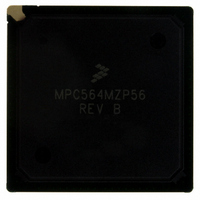MPC564MZP56 Freescale Semiconductor, MPC564MZP56 Datasheet - Page 178

MPC564MZP56
Manufacturer Part Number
MPC564MZP56
Description
IC MCU 512K FLASH 56MHZ 388-BGA
Manufacturer
Freescale Semiconductor
Series
MPC5xxr
Specifications of MPC564MZP56
Core Processor
PowerPC
Core Size
32-Bit
Speed
56MHz
Connectivity
CAN, EBI/EMI, SCI, SPI, UART/USART
Peripherals
POR, PWM, WDT
Number Of I /o
56
Program Memory Size
512KB (512K x 8)
Program Memory Type
FLASH
Ram Size
32K x 8
Voltage - Supply (vcc/vdd)
2.5 V ~ 2.7 V
Data Converters
A/D 32x10b
Oscillator Type
External
Operating Temperature
-40°C ~ 125°C
Package / Case
388-BGA
Core
PowerPC
Processor Series
MPC5xx
Data Bus Width
32 bit
Maximum Clock Frequency
56 MHz
Data Ram Size
32 KB
On-chip Adc
Yes
Number Of Programmable I/os
56
Number Of Timers
2
Operating Supply Voltage
0 V to 5 V
Mounting Style
SMD/SMT
A/d Bit Size
10 bit
A/d Channels Available
32
Height
1.95 mm
Interface Type
CAN, JTAG, QSPI, SCI, SPI, UART
Length
27 mm
Maximum Operating Temperature
+ 125 C
Minimum Operating Temperature
- 40 C
Supply Voltage (max)
2.7 V, 5.25 V
Supply Voltage (min)
2.5 V, 4.75 V
Width
27 mm
For Use With
MPC564EVB - KIT EVAL FOR MPC561/562/563/564
Lead Free Status / RoHS Status
Contains lead / RoHS non-compliant
Eeprom Size
-
Lead Free Status / Rohs Status
No RoHS Version Available
Available stocks
Company
Part Number
Manufacturer
Quantity
Price
Company:
Part Number:
MPC564MZP56
Manufacturer:
FREESCAL
Quantity:
364
Company:
Part Number:
MPC564MZP56
Manufacturer:
Freescale Semiconductor
Quantity:
10 000
Part Number:
MPC564MZP56
Manufacturer:
FREESCALE
Quantity:
20 000
Company:
Part Number:
MPC564MZP56R2
Manufacturer:
Freescale Semiconductor
Quantity:
10 000
- Current page: 178 of 1420
- Download datasheet (11Mb)
Central Processing Unit
For a complete list of simplified mnemonics, see the RCPU Reference Manual. Programs written to be
portable across the various assemblers for the PowerPC ISA architecture should not assume the existence
of mnemonics not described in that manual.
3.10.3
The effective address (EA) is the 32-bit address computed by the processor when executing a memory
access or branch instruction or when fetching the next sequential instruction.
The PowerPC ISA architecture supports two simple memory addressing modes:
These simple addressing modes allow efficient address generation for memory accesses. Calculation of the
effective address for aligned transfers occurs in a single clock cycle.
For a memory access instruction, if the sum of the effective address and the operand length exceeds the
maximum effective address, the storage operand is considered to wrap around from the maximum effective
address to effective address 0.
Effective address computations for both data and instruction accesses use 32-bit unsigned binary
arithmetic. A carry from bit 0 is ignored in 32-bit implementations.
3.11
The PowerPC ISA exception mechanism allows the processor to change to supervisor state as a result of
external signals, errors, or unusual conditions that arise in the execution of instructions. When exceptions
occur, information about the state of the processor is saved to certain registers, and the processor begins
execution at an address (exception vector) predetermined for each exception. Processing of exceptions
occurs in supervisor mode.
Although multiple exception conditions can map to a single exception vector, a more specific condition
may be determined by examining a register associated with the exception — for example, the DAE/source
instruction service register (DSISR). Additionally, some exception conditions can be explicitly enabled or
disabled by software.
The PowerPC ISA architecture requires that exceptions be taken in program order; therefore, although a
particular implementation may recognize exception conditions out of order, they are handled strictly in
order with respect to the instruction stream. When an instruction-caused exception is recognized, any
unexecuted instructions that appear earlier in the instruction stream, including any that have not yet entered
the execute state, are required to complete before the exception is taken. For example, if a single
instruction encounters multiple exception conditions, those exceptions are taken and handled sequentially.
Likewise, exceptions that are asynchronous and precise are recognized when they occur, but are not
handled until all instructions currently in the execute stage successfully complete execution and report
their results.
3-34
•
•
EA = (rA|0) + 16-bit offset (including offset = 0) (register indirect with immediate index)
EA = (rA|0) + rB (register indirect with index)
Exception Model
Calculating Effective Addresses
MPC561/MPC563 Reference Manual, Rev. 1.2
Freescale Semiconductor
Related parts for MPC564MZP56
Image
Part Number
Description
Manufacturer
Datasheet
Request
R

Part Number:
Description:
MPC5 1K0 5%
Manufacturer:
TE Connectivity
Datasheet:

Part Number:
Description:
MPC5 500R 5%
Manufacturer:
TE Connectivity
Datasheet:

Part Number:
Description:
MPC5 5K0 5%
Manufacturer:
Tyco Electronics
Datasheet:

Part Number:
Description:
MPC5 5R0 5%
Manufacturer:
Tyco Electronics
Datasheet:

Part Number:
Description:
MPC5 50K 5%
Manufacturer:
Tyco Electronics
Datasheet:

Part Number:
Description:
MPC5 1R0 5%
Manufacturer:
Tyco Electronics
Datasheet:
Part Number:
Description:
Manufacturer:
Freescale Semiconductor, Inc
Datasheet:
Part Number:
Description:
Manufacturer:
Freescale Semiconductor, Inc
Datasheet:
Part Number:
Description:
Manufacturer:
Freescale Semiconductor, Inc
Datasheet:
Part Number:
Description:
Manufacturer:
Freescale Semiconductor, Inc
Datasheet:
Part Number:
Description:
Manufacturer:
Freescale Semiconductor, Inc
Datasheet:












